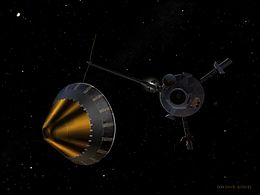Galileo Probe

Illustration of Galileo Probe release from carrier
|
|
| Mission type | Lander / Atmospheric probe |
|---|---|
| Operator | NASA |
| COSPAR ID | 1989-084C |
| Spacecraft properties | |
| Manufacturer | Hughes Aircraft Company |
| BOL mass | 339 kg (747 lb) |
| Start of mission | |
| Launch date | October 18, 1989 |
| Rocket | STS-34 piggybacking with Galileo orbiter |
The Galileo Probe was an atmospheric-entry probe carried by the main Galileo spacecraft to Jupiter, where it directly entered a hot spot and returned data from the planet. The 339-kilogram (747 lb) probe was built by Hughes Aircraft Company at its El Segundo, California plant, measured about 1.3 meters (4.3 ft) across. Inside the probe's heat shield, the scientific instruments were protected from extreme heat and pressure during its high-speed journey into the Jovian atmosphere, entering at 47.8 kilometers (29.7 mi) per second. It entered Jupiter on December 7 1995, 22:04 UTC and stopped functioning 23:01 UTC, 57.6 minutes later.
The probe was released from the main spacecraft in July 1995, five months before reaching Jupiter, and entered Jupiter's atmosphere with no braking beforehand. The probe was slowed from its arrival speed of about 47 kilometers per second to subsonic speed in less than two minutes. The rapid flight through the atmosphere heated the heat shield to around 15,500 °C (28,000 °F).
At the time, this was by far the most difficult atmospheric entry ever attempted; the probe had to withstand a deceleration of 230 g and the probe's 152 kg heat shield, making up almost half of the probe's total mass, lost 80 kg during the entry. NASA built a special laboratory, the Giant Planet Facility, to simulate the heat load, which was similar to the convective heating experienced by an ICBM warhead reentering the atmosphere combined with the radiative heating of a thermonuclear fireball. It then deployed its 2.5-meter (8.2-foot) parachute, and dropped its heat shield, which fell into Jupiter's interior.
As the probe descended through 156 kilometres (97 mi) of the top layers of the Jovian atmosphere, it collected 58 minutes of data on the local weather. It only stopped transmitting when the ambient pressure exceeded 23 atmospheres and the temperature reached 153 °C (307 °F). The data was sent to the spacecraft overhead, then transmitted back to Earth. Each of 2 L-band transmitters operated at 128 bytes per second and sent nearly identical streams of scientific data to the orbiter. All the probe's electronics were powered by lithium sulfur dioxide (LiSO2) batteries that provided a nominal power output of about 580 watts with an estimated capacity of about 21 ampere-hours on arrival at Jupiter.
...
Wikipedia
